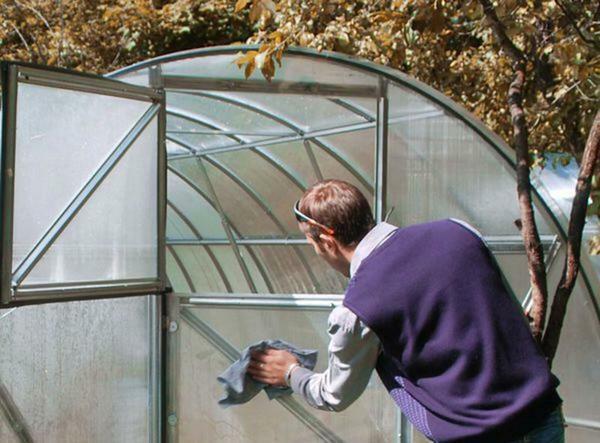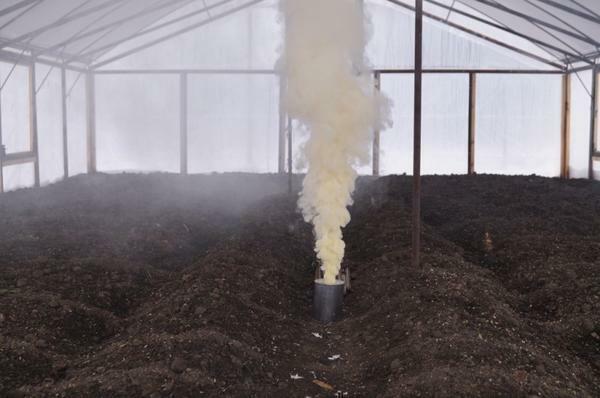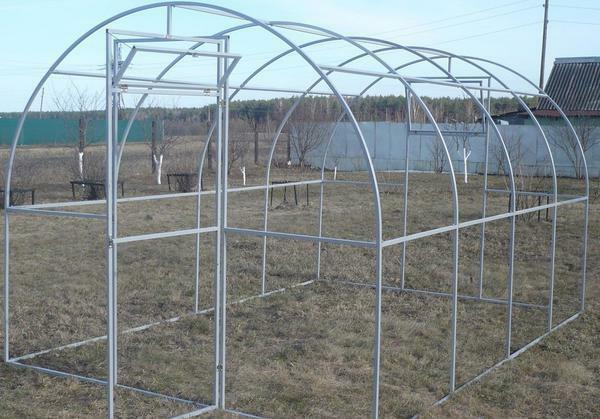How to decontaminate the land in a greenhouse is a question that interests many gardeners When a greenhouse is built in a country house or a farmstead, it does not always produce a good harvest and excellent fruits. It's not a secret that plants take their nutrients out of the soil. Cultivation of such a crop is usually enough for 1-2 seasons, then everything is replaced by a struggle with all kinds of parasites, pests and diseases. And often the victory goes to the parasites, and the owner simply tolerates their presence. So, to ensure that the site does not have such a defeat before the microbes, you need to know about several ways to deal with them. How to do it more effectively, by what methods and methods, it is necessary to understand.
- How to decontaminate the polycarbonate greenhouse in the spring: preparation
- Disinfection of the greenhouse in autumn:
- How to disinfect the soil in the greenhouse( video)
How to decontaminate the polycarbonate greenhouse in spring: preparing
Spring, a beautiful time, and everything comes to life after winter, but along with all this, more and more malicious microBov and parasites. For them, just favorable conditions for reproduction occur.
To prevent their reign in the greenhouse, it is necessary to think about methods of struggle earlier.
Below we will try to understand more clearly how to decontaminate a polycarbonate greenhouse. If you grow in a glassed or film greenhouse, there's nothing terrible, the general principle of disinfection remains unchanged.
 Preparing a greenhouse made of polycarbonate for the new season is necessary very carefully
Preparing a greenhouse made of polycarbonate for the new season is necessary very carefully
The preparation can include:
- Try as best as possible to remove crop residues from the past harvest such as leaves, leaves, rotten fruit - thisIt is better to burn everything. You can of course make a compost of everything, but this is not a good action in terms of infectious safety.
- You also need to completely remove all possible remnants of pegs, ropes, garters.
- Inspect the greenhouse for damage, if any, then repair.
After changing the time of the year, before planting new plants, it is necessary to disinfect the greenhouse, and since polycarbonate greenhouses have flat planes, their processing will not be very difficult. Unlike glass, polycarbonate is easy to damage. To prevent this, you should use a soft rag. In order to disinfect the structure, you can use a solution of household soap or weak chemicals. Apply great effort is not necessary, if the dried stain is left, then it just needs to be moistened and after a short amount of time it will easily wipe off.
Disinfection of greenhouses in autumn:
compositions. In spring and autumn, the greenhouse needs to be decontaminated. Before disinfection in the fall, you need to think about which plants will be planted. After all, not all plants are favorably affected by pesticides.
For some, growth will be slowed, for others - the quality of the fetus is impaired.
Safe disinfection in autumn can be carried out using a solution of potassium permanganate. The proportions of the solution should be approximately the following: 1 tsp of potassium permanganate per water bucket. In contrast to spring, when all the parasites try to get out, in the fall they are on the contrary, they start hammering into different cracks.
 Greenhouse disinfection process in autumn
Greenhouse disinfection process in autumn
Procedure nuances:
- In order not to leave bacteria a chance to winter life in the greenhouse, pay special attention to the frames, doors and all kinds of joints.
- When mold is formed, it is urgently removed, it can be scraped off with a knife, and in no case should it be thrown in a greenhouse, the best option is disposal in a bucket, and then rinse the knife with a disinfectant solution.
- Everything that is taken out of the greenhouse - burn.
- It will also be necessary to remove all the branches, remains of the leaves, which also need to be burned to prevent the sick plants that carry disease germs from passing by their eyes.
- Putting the remains into a pit for compost, too, should not be allowed.
- If, after all, the earth is heavily contaminated and attacked by several kinds of parasites, then it is best to change the land in the greenhouse.
To replace the soil, it is necessary to remove a layer of ground about 20 cm and fill it with a new one, preferably with fertilizers for a good bait. Old land can also be disinfected and then re-used the next year. But for this it is necessary to allocate a plot in the garden for disinfection.
Methods of soil disinfection in the greenhouse
The soil contains a very large number of microbes and bacteria. In addition to microbes, there are also fungi and larvae. Reproduction of these parasites also occurs in the earth. For this, the soil is treated in a greenhouse. There are many methods for treating soil in greenhouses from parasites. In order to sanitize the greenhouse, consider the main methods.
Basic processing methods:
- Chemical;
- Thermal;
- Phyto cleaning.
 Smoke gum is an excellent way to decontaminate the soil in the greenhouse
Smoke gum is an excellent way to decontaminate the soil in the greenhouse
These basic methods will help to get rid of parasitic germs and clean the ground in the greenhouse. Of course, there are other ways. For example, electrode methods of soil sterilization have not badly proven themselves. They are rarely used, and even then in industrial-scale greenhouses.
The principle of operation is simple, special plates are inserted into the ground, which are heated. Having reached certain temperatures, the bacteria die.
Good and effective means can also be attributed to the checkers with the chemical substance inside. The application is very simple. We close all the windows and doors. We put the sword in the center of the greenhouse, preferably on a flat and stable surface. Remove the head, and ignite the wick. It is necessary to leave the room until it is filled with the substance. At the heart of this substance is sulfur. It impregnates the ground, and after the application of the greenhouse can not be opened for about 2 weeks. Do not forget that the use of sulfur in large quantities will be deplorable for the soil. Recommended use once a year. For more effective use of the checkers, you can moisten the walls inside the greenhouse. After the expiration date, the greenhouse also needs to be thoroughly washed, and manure or other fertilizers should be added to the ground. Disinfection of the soil, this is the necessary measures in the fight against parasites.
Methods of soil disinfection in the greenhouse
Let's consider in more detail the methods that were described earlier. So, the chemical method is when the land is watered with a solution of copper sulfate or dissolved in potassium permanganate, the proportions of which are 1 tsp per bucket of water. The next way is thermal, this option is available for everyone. Boil the water in a bucket, and pour it on a piece of land that must be decontaminated. After pouring out water, a thick film is taken and the area is covered.
 The soil in the greenhouse can be decontaminated chemically or thermally
The soil in the greenhouse can be decontaminated chemically or thermally
The temperature of the vapor under the film will destroy a significant portion of the pests and fungal bacteria. Also, a steam cleaner can and wash the walls of the greenhouse. Steam will penetrate into every slot and corner, leaving no chance for pests. Phyto cleaning is the use of herbs. It's no secret that there are useful herbs that have bactericidal qualities, and besides that, the smell of some of them can simply scare off pests.
Tips: how to decontaminate the land in the greenhouse( video)
These simple methods will help decontaminate the soil in the greenhouse and ensure victory over pathogenic parasites and all sorts of fungi. Decontamination of soil, replacement of land, additives of humus are one of the correct steps to a good harvest. The absence of pathogenic bacteria is the key to a healthy, healthy harvest, because in our days it is difficult to find natural products grown not on chemicals. And the estate of his own greenhouse, this is a great pleasure.


